Susan Price's Blog: Susan Price's Nennius Blog, page 8
April 24, 2015
'And He Was Carrying Fire' - Writers Researching...
This is an adaptation of a talk I gave recently at the Birmingham Midlands Institute,
 The Royal Literary Fundfor the Royal Literary Fund's programme of talks open to the public. I was one of three writers - the others were Jane Bingham and Mike Harris.
The Royal Literary Fundfor the Royal Literary Fund's programme of talks open to the public. I was one of three writers - the others were Jane Bingham and Mike Harris.I wish I could give an account of their talks, as they were fascinating and opened up many questions for discussion - but, as I was in the thick of it, so to speak, I couldn't make notes.
The panel was about 'Research for Writers.'
I have heard other writers talk of hours in the archives, or interviewing experts — not for me. Mostly I make it up.
Take my Sterkarms books —
These are sci-fi/fantasy/historicals… Part of them is set in the 21st Century, most of them in the early 16th, on the Scots Borders.
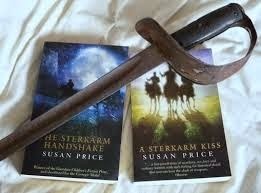
I did research them, but not in the 'hours in the library' sense.
More in the ‘getting sodden and cold on Scottish hillsides’ sense.
I first had the idea for the books while on a walking holiday along Hadrian's Wall, where I kept hearing mention of the Rievers. I then read MacdonaldFraser's Steel Bonnets and Godfrey Watson's Border Rievers, both of which are excellent sources of information about the rievers.
But does this count as research? I would have read these books anyway, from general interest. The fact that I used them, later, as reference was just – lucky.
When I have what I feel is a good idea for a book, I’m usually too impatient to begin writing to waste time researching. After all, I write fiction. I make it up. When I wrote the 16th Century sections of the Sterkarm books I relied on what I remembered from the books I'd read on the rievers, what I knew from general reading about the period, and a lot of educated guessing.
My approach has always been, 'If I was on the Borders in 1520 and had only the materials available that they had, and I wanted to do X, Y, Z — how would I solve that problem? And, I figure, if I could think of that solution, they did too.
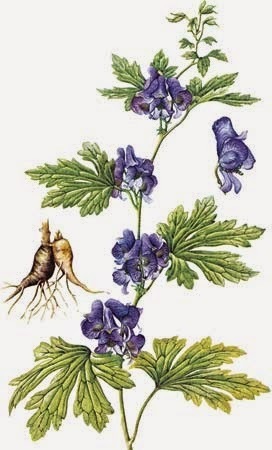 Wolfsbane: beautiful and lethal For instance, one of my characters, a bit of a witch, makes a painkiller by mixing wolfsbane with fat — not baby’s fat, just dripping. How would she store this lethal stuff? (Wolfsbane, AKA monkshood or aconite, is extremely poisonous in its every part - root, leaf, stem and flower. It's said that even the scent of its flowers in a room can make people ill.) My witch doesn’t have any Tupperware, she lives in the middle of nowhere, and I imagine even the crudest pots are an expense she'd find it hard to meet.
Wolfsbane: beautiful and lethal For instance, one of my characters, a bit of a witch, makes a painkiller by mixing wolfsbane with fat — not baby’s fat, just dripping. How would she store this lethal stuff? (Wolfsbane, AKA monkshood or aconite, is extremely poisonous in its every part - root, leaf, stem and flower. It's said that even the scent of its flowers in a room can make people ill.) My witch doesn’t have any Tupperware, she lives in the middle of nowhere, and I imagine even the crudest pots are an expense she'd find it hard to meet.In thinking about what she’d have available, I thought of mouse-nibbled hazel-nuts. I said she scraped her ointment into the hollow nuts and sealed them with wax.
Prove me wrong. Prove that no woman anywhere, anywhen, ever did that. You can't, can yer?
Making up my own answers, like this, means I can leave research until later while I go on sorting out my plot. In my experience, a new finding from research rarely ruins your plot — at most, it will need a few tweaks.
But endless, perfectionist research will prevent you from ever writing your book.
In any case, a lot of what I want to know can’t be found in books or archives.
What is it like to use a longbow? — Again, I owned a longbow long before I came to describe its use, because I'd always wanted to use a longbow.
What is it like to ride a horse? — I took a week-long riding course in Northumbria, where I learned how to fall off a horse.
What is like to sleep in one of those little cupboard beds, with a hay-filled mattress supported on ropes? — I sneaked into one in an Orkney museum when no one was around and found out.
You can't really find out about any of these things by researching in a library. You can read what others have written about them, but it won't give you the experience of drawing back the weight of a longbow, the personality of a horse, the smell of old grass and wood in the wall-bed.
I've also found that some of the most interesting, useful details are discovered when I'm not researching at all.
For instance, I wondered how my rievers would make fires - especially when they were travelling on raids. How did they light fires at home in the pele tower? I knew they wouldn't have had matches, but doubted that they spent much time rubbing sticks together. I researched in the usual way and the answer, of course, was tinderboxes.
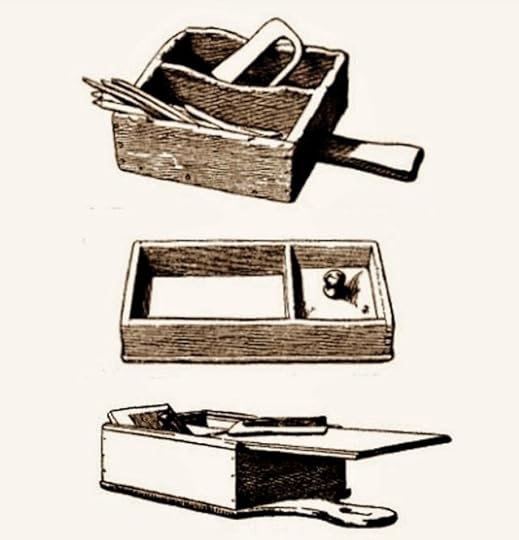 English tinderboxes, 18th-19th century (Wikimedia commons)
English tinderboxes, 18th-19th century (Wikimedia commons) When I used to read Andersen's 'Tinderbox' as a child, I had a vague idea that it was something like a modern lighter, that somehow made a flame by itself. In reality, it was a box where you kept all your fire-making equipment together in one place. It 'kept your tinder dry' and you always knew where to find the things you needed.
There was the firesteel. In the picture below, this is at the bottom. It is shaped to fit round the hand, to make it easier to use.
There was the flint - seen in the top right-hand corner. It might not actually be a flint, but a piece of any hard stone, which would create a spark when struck on the steel.
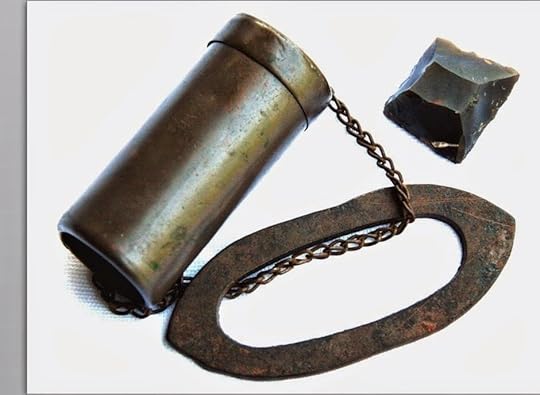
And then there was the tinder, which you kept dry in the box. This might be pieces of charred cloth, very dry plant material, or 'punk' which was the dry, powdery rotted wood from the centre of a dead tree.
You struck sparks from the steel with the flint, and let them fall on the tinder in the box — and when a spark started to smoulder, you blew on it until you had a flame. You lit one of your spills in the flame and transferred the flame to a candle, or to the kindling for your fire…
Most of the information I could find was of 18th or 19th century tinderboxes, but they were certainly used earlier — because here's Joseph striking a light for the Holy Family…
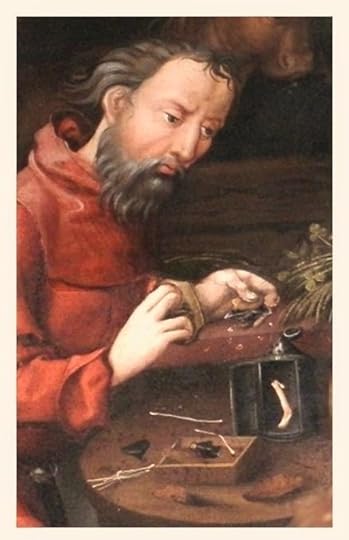
In this detail (below), you can see that St. Joe has the fingers of his right hand through the steel, and is holding the flint in his left. His tinder box is under the flint, ready to catch the flame. He has spills scattered around, ready to light at the flame when it catches. And under his left hand is an open lantern, holding a somewhat bent candle. He will light the candle from the lit spill.
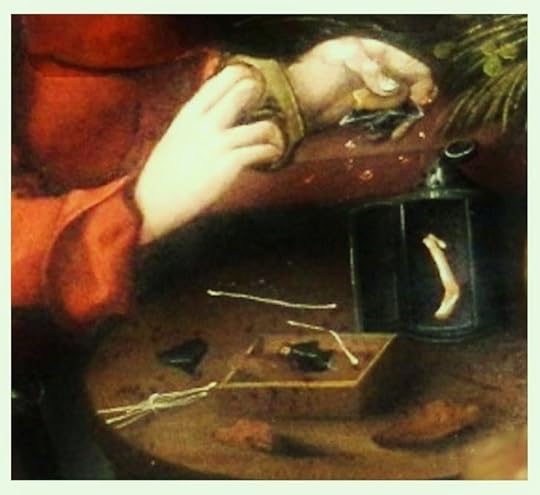
People used to have small tinder-boxes they could carry with them. So that's what I found out by what you might call 'formal research.' And I'm glad to know it. You never know when information on tinderboxes will come in useful. Which is why I'm keeping it all in my Research File.
However, it never seemed quite right to me for the rievers. I knew that people carried fire with them — I'd heard of fire being carried out to field, or about castles in 'fire-pots.' I know from family gossip that, more recently, one neighbour would help another out by carrying a shovel-full of hot coals from one house to another.
Carrying a fire-pot of hot coals on horseback seemed unlikely, though. Especially if, like the reivers, you never knew when you were going to have to gallop for your life.
Then, I read No Country For Old Men, by Cormac Macarthy. This had nothing to do with any research. I read the book purely because I wanted to.
In the book, the elderly narrator has a dream where he's riding at dusk, and sees his dead father ride past him on horseback and ride on ahead of him into the darkness. The narrator says, ‘and he was carrying fire.’
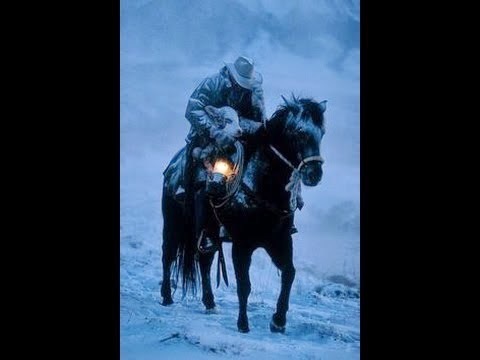 'carrying fire'
'carrying fire'The phrase about carrying fire seemed to carry a lot of weight, but I didn't understand it, or its significance. I puzzled about it quite a lot. Was I to imagine the father carrying a crown of fire on his head, like something out of William Blake, or a flaming torch, or what?
Then, on-line, I came across a forum where people were discussing the book and the Coen Brothers film of it. A lot of other people seemed puzzled by 'and he was carrying fire,' too.
Another poster explained it. He introduced himself (I assume it was 'him') as a survivalist, who had researched the old ways of life, before the arrival of electricity and the internet. The significance of 'and he was carrying fire' is that the narrator, an elderly man, dreams of his dead father riding on ahead of him into the dark. The father is carrying glowing embers in a cow-horn at his belt, so that he can make camp somewhere up ahead and wait for the narrator to join him. This is what used to be done 'on the trail' - one man would go ahead, with fire, make camp and have a fire burning ready for when the others joined him. So the phrase is a rather beautiful dream metaphor for the elderly narrator facing death. His father, he feels, will be waiting for him, somewhere up ahead in the dark, sitting beside a campfire.
The survivalist went on to explain how carrying fire was done. You took a hollow
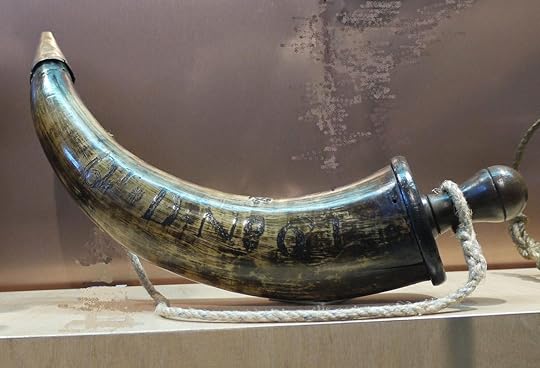 cow’s horn, and made a lid for it, from metal or leather, or horn. The lid had to be pierced, to let in the air. The horn also had a strap, so it could be carried at a belt or saddle.
cow’s horn, and made a lid for it, from metal or leather, or horn. The lid had to be pierced, to let in the air. The horn also had a strap, so it could be carried at a belt or saddle.You then put smouldering embers into the horn, added some punk or other tinder, to keep them smouldering, and insulated them with ash, or dried moss or punk.
The amount of air getting into the horn was crucial. Too much and the embers burst into flame, which is obviously a problem if it’s hung on your belt. Too little air and the embers died. But if you got it right, you had the immediate makings of a fire when you reached your camp place — without having to struggle with other methods when it might be cold, windy or damp. (Which, in Scotland…)
Other survivalists, who’d tried this, added that you should put a slab of wood, or thick leather, between you and the horn as you carried it, because it got very hot.
Now No Country For Old Men is set in Texas, and there are lots of connections between the Border reivers and the American South — many reivers were transported there for their crimes. Which is why some of the most complete Scots ballads and folk-tales were collected in the Carolinas, and not in Scotland.
The reivers of Lowland Scotland and Northern England were herding cattle on horseback for roughly 200 years before Columbus. Many of the Wild West’s cowboys were, in fact, Scots and Geordies. So, I figured, if they carried fire like this in Texas in the early 20thCentury, they also did it in the Borders in the 16th. Why wouldn’t they? — They had the cows, and the horns, and the need to carry fire.
Prove that not one of them ever did. You can't, can yer.
I suppose that my point, in all this, is that although research in libraries is enormously important, researching fiction encompasses everything you’re interested in, and anything you observe, all the time. It is sounds, tastes, smells – it’s which muscles and joints take the most pressure during the task you’re describing. It's the feeling of a fire's heat on your skin, and the scent of roses in a warm garden.
It's bringing together things that intuition tells you are true, even if you can't prove it - rather like inventing a story.
For a writer, your sensual memory and imagination are the most important libraries of all.
All images: Wikimedia Commons.
Published on April 24, 2015 16:00
April 10, 2015
Reasons To Be Cheerful, 2015
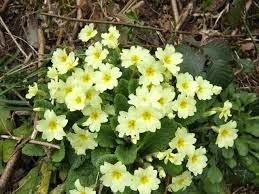 Spring is sprungThe grass is rizI wonder where those birdies is.They're on the wing - Now that's absurd.The wing is always on the bird.
Spring is sprungThe grass is rizI wonder where those birdies is.They're on the wing - Now that's absurd.The wing is always on the bird.My Dad recited this, at about this time, every year. So now I repeat it, in memory of him, and to greet the sprung spring.
That's one reason to be cheerful. Here's more - well, for me, anyway.
 I took some time off this week, and went over to the archery field with my longbow. I set up my own butt at 40 feet, quite a way from everyone else, and spent a peaceful time, in the sun, shooting. I was so close to the target, I could almost have leaned over and stuck the arrows in, but I was able to take my time and think. A fellow longbow-ist at the club had advised me to ignore all other advice, and to keep both eyes open while I shot - so I did, and found my aim much improved. Whereas before, closing one eye, I'd been unable to hit even such a close target. My shots had been going far over, under, to the left, to the right.
I took some time off this week, and went over to the archery field with my longbow. I set up my own butt at 40 feet, quite a way from everyone else, and spent a peaceful time, in the sun, shooting. I was so close to the target, I could almost have leaned over and stuck the arrows in, but I was able to take my time and think. A fellow longbow-ist at the club had advised me to ignore all other advice, and to keep both eyes open while I shot - so I did, and found my aim much improved. Whereas before, closing one eye, I'd been unable to hit even such a close target. My shots had been going far over, under, to the left, to the right.With both eyes open, I'm very cheerful to report, I only missed the
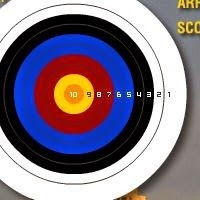 An archery face and scores.butt about three times in some 90 minutes of shooting. (Thank you, Keith.) The rest of the time I was putting the arrows mostly in the blue (scores 5) or in the red (scores 7.) I put it in the gold ten times. I was aiming at gold all the time, of course. Gold scores nine.
An archery face and scores.butt about three times in some 90 minutes of shooting. (Thank you, Keith.) The rest of the time I was putting the arrows mostly in the blue (scores 5) or in the red (scores 7.) I put it in the gold ten times. I was aiming at gold all the time, of course. Gold scores nine.I was also bunching the arrows very closely, or placing them in a lovely straight line across the target - which shows consistency of technique and aim. I wasn't shooting wildly and putting them just anywhere (as I had been before) but was placing them in straight lines approaching closer to the Gold, even if I didn't actually hit it.
This is a huge improvement in my shooting - just by keeping both eyes open! - and I was very cheerful about it. The great, meaty thwack! of an arrow hitting the soft centre of the target is a very cheering thing too. (Although it makes you reflect on just how much iron-tipped force is being unleashed, and that these things are weapons.)
Every now and then I would stop shooting and realise that I was standing in warm sunshine, on a field surrounding by tall, beautiful trees, under a blue and almost cloudless sky in which a buzzard was idly circling. Another reason to be cheerful.
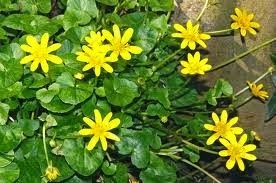 At my back, as I shot, was a busy road. A strip of land between the road and the archery field had been fenced off, and this strip of land had become a little wood (as all land, left to itself, in Britain, does.) A stream was trickling along it, just on the other side of the field's edge - and all the ground in this little wood was spangled and sparkling with celandine and primroses, as they grabbed their chance before the trees leafed up and blocked all the sunlight. Looking at them made me very cheerful.
At my back, as I shot, was a busy road. A strip of land between the road and the archery field had been fenced off, and this strip of land had become a little wood (as all land, left to itself, in Britain, does.) A stream was trickling along it, just on the other side of the field's edge - and all the ground in this little wood was spangled and sparkling with celandine and primroses, as they grabbed their chance before the trees leafed up and blocked all the sunlight. Looking at them made me very cheerful.And then I skived off again yesterday, and walked by the River Severn. There were plums, cherries and magnolias all joyously shaking out their blossom, green hills, blue skies - and it was positively hot. I got a bit sunburned. First time this year.
What's made you cheerful recently? Let's be hearing from you - !
Published on April 10, 2015 16:00
March 27, 2015
Oh. Those Short Knights...
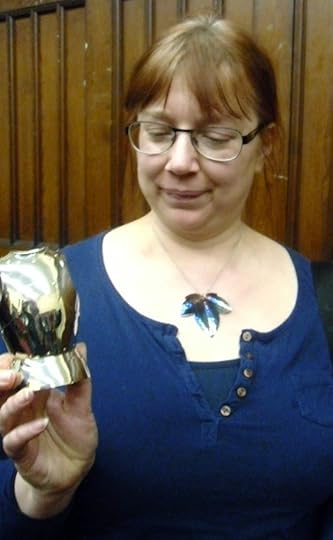 Jane Adams, Crime novelistThis is Jane Adams, Crime novelist, photographed at a recent RLF do. She's wearing a beautiful cut steel pendant made by her husband - but look at what she's holding.
Jane Adams, Crime novelistThis is Jane Adams, Crime novelist, photographed at a recent RLF do. She's wearing a beautiful cut steel pendant made by her husband - but look at what she's holding. It's a miniature suit of armour - the back and chest plates. It's one third scale. (I apologise for the poor photo - entirely my fault.)
Jane's husband, Julian Adams, used to be an electronic engineer, and began making armour as a hobby. Some hobby. He researched, and taught himself the techniques needed - though he does use power-tools.
Soon, as passionately loved, creative hobbies do, armoury started taking up most of his time and money - so he went professional, and now, as Swordweaver Armoury, creates suits of armour for collectors, museums, and re-enactors.
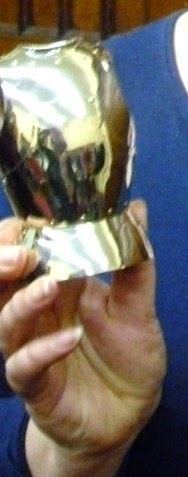 Detail
DetailAt the moment, he's creating some miniature knights on horseback, with to-scale suits of armour for both knights and horses. Jane is assisting by stitching tiny sets of undercrackers, shirts and breeches for the short knights to wear under their armour.
When Jane told me about this, some weeks ago, I was fascinated and asked to see photos - which she duly sent me. But when I went to the RLF poetry evening Jane produced a soft cloth bag and, with a flourish, drew from it, this little steel body-suit.
It was exquisite, with every detail present. The brightly polished steel shone.
Below are the photos Jane sent me. In this first one, you can see that the horses are wearing helmets. (I don't know what the proper name is for armour a horse wears on its head.)
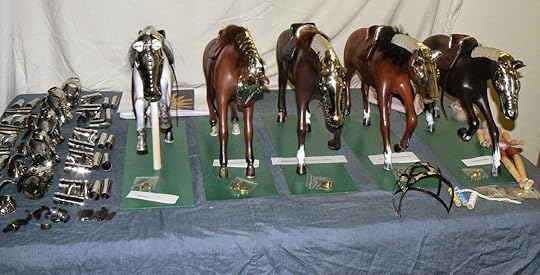
Here, below, you have a somewhat better view of the tiny helmets, breastplates, greavcs and other body armour laid out beside the horses, ready for the knights.
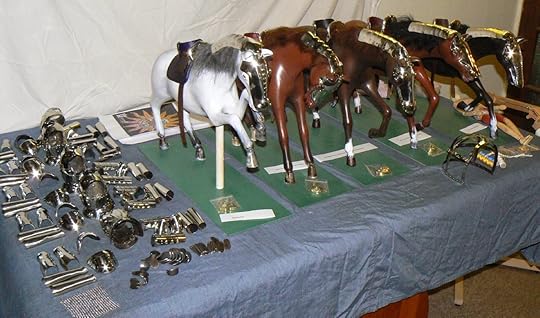
Here's a still better view of those gleaming, shining steel suits.
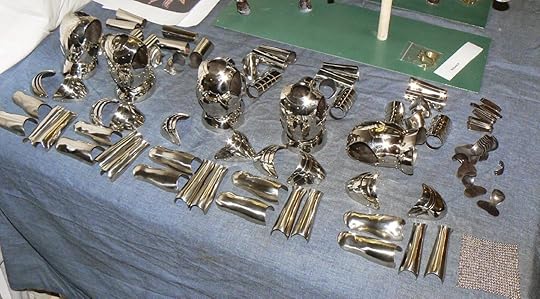
A beautiful slide show of Julian's beautiful armour and jewellery can be seen on his website.
I really like the look of this 'random' jewellery, made of steel with brass inlay.
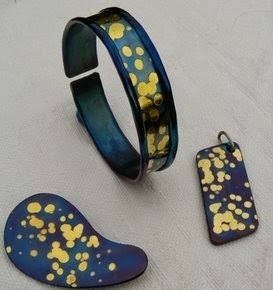 Julian Adams, jewellery
Julian Adams, jewellery
Published on March 27, 2015 17:00
March 20, 2015
'Let The Poet Choose'
 Royal Literary FundIt was the second public event for RLF (Royal Literary Fund) Brum on Thursday night once more held in the Birmingham and Midland Institute.
Royal Literary FundIt was the second public event for RLF (Royal Literary Fund) Brum on Thursday night once more held in the Birmingham and Midland Institute.This time the evening was given over to three of the many poets the RLF can field - by name, Duncan Forbes, who acted as host, Judy Brown and Cliff Yates.
I already knew Duncan slightly, because I was his 'mentor' when he was the RLF Fellow at Worcester. So I expected him to be gentle and charming, and he was, introducing his fellow poets and leading the applause, and reading his own work last.
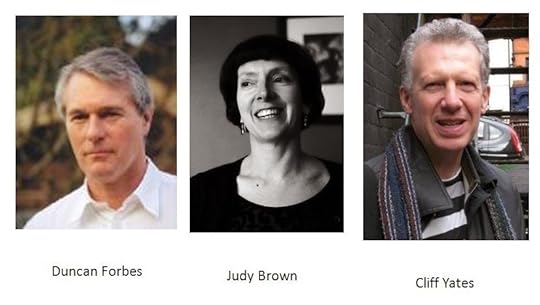 Duncan told us of a now revered anthology of poetry published in 1973: 'Let The Poet Choose.' Each poet chose the work that they felt represented them best - and explained why the work was special to them, and why they chose it.
Duncan told us of a now revered anthology of poetry published in 1973: 'Let The Poet Choose.' Each poet chose the work that they felt represented them best - and explained why the work was special to them, and why they chose it.So Cliff told us about how a poem had stemmed partly from a robber's attempt on his hat, partly from Stravinsky's 'A Soldier's Tale' and partly from John Cage's 4'33.
This was Cliff's poem, 'Tonight in Kidderminster.'
TONIGHT IN KIDDERMINSTER

begins under streetlights and their word is Speed.
Two of them, chewing gum with their mouths open,
thumbs in their pockets and feet tapping.The tall one sees me first, sees the hat. This hat
goes with the hair, the desert boots and jeans,
the shabby raincoat and ripped gold lining...
To read the rest, follow the link to Cliff's site and scroll down. (I don't like to post someone else's work in full here.) Judy Brown said it was difficult to trace exactly where a poem came from as 'a poem gobbles up whatever it needs.'
She read us, The Cheese Room - and one of the things that this poem gobbled up, she said, was having lunch with her mother in this restaurant...
 The Cheese Room
The Cheese Room
Here it is, on the back of the menu.
How, instead of a pudding, an extra fiver
will buy you the choice of the Cheese Room.
It shines in the corner, a treasury,
the moony glow of the cheeses walled round
with glass. As soon as she sees it, she's lost.
Before anyone spots her, she strips,
soaks a sari in buttermilk, wraps herself up
and goes in...To read the rest, follow this link to the Guardian, where it appeared as 'poem of the week.'
Duncan almost apologised for being 'a formalist.' He read us La Brea, inspired by the La Brea tar-pit, where an ancient lake holds the bones of hundreds of animals that were trapped and drowned in the tar. It's an elegy for prehistoric dead.
LA BREA

I am the tarred and feathered stork
Who flapped its limbs until they stuck.
I am a tapir ancestor
Who came for water, swallowed tar.
This is the asphalt killing-ground,
A lake that thirsts. Beware. Be warned.
His trunk a blowhole out of reach,
A mammoth trumpets liquid pitch...
As before, follow this link to Duncan's website, and the rest of the poem.
After the readings, were were able to talk to the poets, congratulate them, ask questions - and catch up with other friends in the audience. And drink wine.
There are other public events coming up from the RLF.
April 16th, A panel of writers - Jane Bingham, Mike Harris and Susan Price, discuss Research.
May 14th, Francis Byrnes and Amanda Whittington - experienced radio writers - discuss 'Writing For Voices.'
June 11th - Debjani Chatterji, Jane Bingham and Susan Price, read and discuss their short stories.
July 9th - Cliff Yates, Louise Page and Jane Rogers, all experienced teachers of creative writing, discuss the question, Can Creative Writing Actually Be Taught?
Published on March 20, 2015 17:00
March 13, 2015
Bad News, I'm afraid...
On Thursday March 12th, 2015, I was at my computer, trying to write, when my brother called and said, "Have you heard the bad news?"
"What?" I said. "What?"
He said, "I've just heard - I'm afraid that Terry Pratchett has died."
And that is bad news - for all lovers of Disc-World, for all lovers of writing.
No more Disc-world books. No more Commander Vimes. No more Lady Sybil. No more Granny Weatherwax or Nanny Ogg.
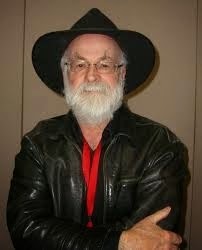 Terry Pratchett It's not just Pratchett himself we have to mourn for - though we've lost an intelligent, compassionate, witty man of wide-ranging empathy and understanding, who raged against injustice and unfairness, and was able to make it a bed-rock of his writing.
Terry Pratchett It's not just Pratchett himself we have to mourn for - though we've lost an intelligent, compassionate, witty man of wide-ranging empathy and understanding, who raged against injustice and unfairness, and was able to make it a bed-rock of his writing.
No, with Pratchett, a whole world dies - the Disc-World. From the crowded, edgy city of Ankh-Morpork, with its benevolent tyrant, its seething streets and its Unseen University of wizards, to the mountains of Lancre with its witches and pragmatic villagers, to forested Uberwald with its vampiric Countess, to the Counterweight Continent and the ancient land of Djelibaby.
Pratchett's inventiveness couldn't be contained in one city, even one as populous and multicultural as Ankh-Morpork - he needed a whole world. And unlike most other fantasy worlds, Pratchett's was ordinary, in the best possible sense. Even his wizards, witches, werewolves, zombies, dwarfs, goblins, trolls and golems had ordinary lives to live.
His was not a fantasy populated by warriors and mages - there were also blacksmiths, daughters-in-law, shop-keepers, policemen, psychos, farmers, journalists, con-men, fishermen, thieves... All human life was encapsulated, understood, sympathised with, made fun of.
We have lost the Thieves' Guild and the Assassin's Guild, Captain Carrot and the ingenious but always discrete tribe of Igors.
All these places and institutions, all these characters, showed us our own world through a slightly distorting mirror. He didn't write fantasy. He wrote reality with a twist.
The series may well be continued by another writer, but the books can never be the same now the Arch-Wizard himself has gone...
I shall be doing a lot of re-reading, I think...
Of course, Master Pratchett had early-onset Alzheimer's, and had said that he wanted this country's laws to be changed, to allow people with terminal or incurable illnesses to choose when they died. Perhaps, instead of selfishly wishing for more books, we should try to be glad that he died, according to the Guardian, “with his cat sleeping on his bed [he was a famous cat-lover] surrounded by his family,” and that his decline into Alzheimer's is over.
How I feel for his family. If I feel this sad, when I never met the man except through his writing, how much worse, how much much worse, it must be for them.
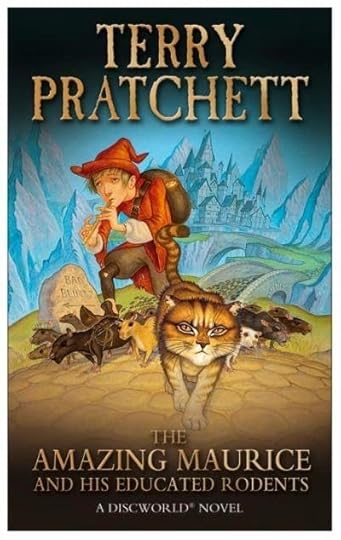
For those who don't understand what Pratchett meant to his fans, here's a link to some of his quotes.
And here's a link to an article in which Pratchett's friend, Neil Gaiman, contests the view that Pratchett was 'a merry elf.' He wasn't, Gaiman says, he was angry.
This comes as no surprise to me. No one could encounter Sam Vimes and Granny Weatherwax - or Vetinari - or Death - and not realise the great fire of angry that was burning underneath them. A great deal of comedy is stoked by anger. See Mel Brooks' The Producers, for example. Much laughter is ridicule, and ridicule is an attack. Brooks himself said that one of the best weapons against thugs like the Nazis is laughter, which cuts them down to size.
As one of the commentators, 'eastofthesun' says, below the line of Gaiman's article,
Goodbye, Terry Pratchett, and thank you so much.
"What?" I said. "What?"
He said, "I've just heard - I'm afraid that Terry Pratchett has died."
And that is bad news - for all lovers of Disc-World, for all lovers of writing.
No more Disc-world books. No more Commander Vimes. No more Lady Sybil. No more Granny Weatherwax or Nanny Ogg.
 Terry Pratchett It's not just Pratchett himself we have to mourn for - though we've lost an intelligent, compassionate, witty man of wide-ranging empathy and understanding, who raged against injustice and unfairness, and was able to make it a bed-rock of his writing.
Terry Pratchett It's not just Pratchett himself we have to mourn for - though we've lost an intelligent, compassionate, witty man of wide-ranging empathy and understanding, who raged against injustice and unfairness, and was able to make it a bed-rock of his writing.No, with Pratchett, a whole world dies - the Disc-World. From the crowded, edgy city of Ankh-Morpork, with its benevolent tyrant, its seething streets and its Unseen University of wizards, to the mountains of Lancre with its witches and pragmatic villagers, to forested Uberwald with its vampiric Countess, to the Counterweight Continent and the ancient land of Djelibaby.
Pratchett's inventiveness couldn't be contained in one city, even one as populous and multicultural as Ankh-Morpork - he needed a whole world. And unlike most other fantasy worlds, Pratchett's was ordinary, in the best possible sense. Even his wizards, witches, werewolves, zombies, dwarfs, goblins, trolls and golems had ordinary lives to live.
His was not a fantasy populated by warriors and mages - there were also blacksmiths, daughters-in-law, shop-keepers, policemen, psychos, farmers, journalists, con-men, fishermen, thieves... All human life was encapsulated, understood, sympathised with, made fun of.
We have lost the Thieves' Guild and the Assassin's Guild, Captain Carrot and the ingenious but always discrete tribe of Igors.
All these places and institutions, all these characters, showed us our own world through a slightly distorting mirror. He didn't write fantasy. He wrote reality with a twist.
The series may well be continued by another writer, but the books can never be the same now the Arch-Wizard himself has gone...
I shall be doing a lot of re-reading, I think...
Of course, Master Pratchett had early-onset Alzheimer's, and had said that he wanted this country's laws to be changed, to allow people with terminal or incurable illnesses to choose when they died. Perhaps, instead of selfishly wishing for more books, we should try to be glad that he died, according to the Guardian, “with his cat sleeping on his bed [he was a famous cat-lover] surrounded by his family,” and that his decline into Alzheimer's is over.
How I feel for his family. If I feel this sad, when I never met the man except through his writing, how much worse, how much much worse, it must be for them.

For those who don't understand what Pratchett meant to his fans, here's a link to some of his quotes.
And here's a link to an article in which Pratchett's friend, Neil Gaiman, contests the view that Pratchett was 'a merry elf.' He wasn't, Gaiman says, he was angry.
This comes as no surprise to me. No one could encounter Sam Vimes and Granny Weatherwax - or Vetinari - or Death - and not realise the great fire of angry that was burning underneath them. A great deal of comedy is stoked by anger. See Mel Brooks' The Producers, for example. Much laughter is ridicule, and ridicule is an attack. Brooks himself said that one of the best weapons against thugs like the Nazis is laughter, which cuts them down to size.
As one of the commentators, 'eastofthesun' says, below the line of Gaiman's article,
"The strength of TP's writing, to me, comes from the tension between his huge compassion and deep cynicism - two seeming opposite traits. And yes, that voice has become stronger over the years... but it's there in all his strongest characters, Vimes and Granny Weatherwax above all but also Death, Susan Sto Helit, Vetinari, Tiffany Aching...All these characters are so different, but that tension runs deep in all of them. The humour is what everyone talks about first, but the passion is what gives it power."I've no idea who 'eastofthesun' is, but I agree entirely. Couldn't have put it better.
Goodbye, Terry Pratchett, and thank you so much.
Published on March 13, 2015 17:00
March 7, 2015
And I'm Out The Other Side...
...Of World Book Day, that is - or rather, the week it takes
 Guess which Urban Myth I told...place in.
Guess which Urban Myth I told...place in.
Over ten days, I went into three schools. I know some writers do much more, but these three visits involved long drives, overnight stays - and I get old, I get old. It was enough for me.
The first school was Arthur Mellow's Collegiate, near Peterborough. So that was a 200 mile drive and an overnight stay. In a chilly B&B, which wasn't quite as freezing as the one I stayed in during December, but still far from comfortable. B&B owners seem to think that England is a suburb of Melbourne, where December through to March is the hottest time of the year.
I spent the entire day at Arthur Mellows working with the same group of 'gifted and talented' pupils, presenting a Creative Writing Workshop. It's unusual, in my experience, for a school to be as bold as this, and I applaud it.
First I told the group a short story, an Urban Folktale.
Then I showed them how the suspense in that story was created, that it's not so much what happens in a story that creates the interest, but largely down to the way it's told. It doesn't matter, in fact, whether a story is about someone's life being endangered by a serial killer, or an old teddy-bear trying to find his lost owner - the story will follow the same pattern, and whether the story works or not will largely depend on how it follows that pattern.
I gave them copies of the story I told them, and had them identify the 'building blocks' of the story. Then I set them the task of inventing their own story, in brief outline. It could be any kind of story - provided it included all the building-blocks we'd looked at. In this way, I hoped to get them to invent a complete story, with a satisfactory ending - and not, as so often happens, to charge off into their first idea, and then be dissatisfied and disappointed because they couldn't find an ending.
They worked on their stories for an hour, while I went round finding out about them. There was an age-range from 11/12 to 14/15, and a wide range of subjects. I encouraged them all to start thinking about their ending. Who did they want to 'win'? Was it to end happily or sadly? With others, I discussed re-arranging their story's elements, to achieve a better structure.
In the hour immediately before lunch, we held a 'writer's surgery' where they heard each other's stories - which were wonderfully varied and imaginative - and gave each other feedback. How well had the building blocks been handled? What worked well about the story? What could be improved?
In the afternoon, we took a look at building character, and setting scene. I enjoyed the day enormously. One student wrote on her feedbac form (and entirely without coercion from me, as I'd left my knuckledusters at home): 'I want to be an author when I’m older and workshops like this one are inspiring and helpful. THANK YOU!'
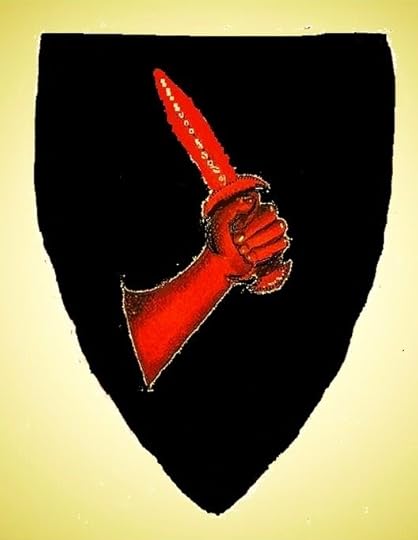 The Sterkarm Handshake At Cardinal Griffin, I've just been appointed their 'Patron of Reading,' and this was a first visit, a 'getting to know you' day. I saw several classes, for an hour each time, and told them something of my life, and about the ideas and research behind my book, The Sterkarm Handshake.
The Sterkarm Handshake At Cardinal Griffin, I've just been appointed their 'Patron of Reading,' and this was a first visit, a 'getting to know you' day. I saw several classes, for an hour each time, and told them something of my life, and about the ideas and research behind my book, The Sterkarm Handshake.
And there was cake for lunch - baked by the lovely librarian, Jacqueline Biddle. Some senior students came along to join us - but had all eaten their packed lunches at break!
It was a fun day, with some very acute questions from the students, and I look forward to working with Griffin again.
Griffin was a mere hour's drive from home - but good lord, the traffic! At roughly 3-45pm, the traffic on Birmingham's car-park (the M6) was so horrendous that I pulled off and drove home through the urban sprawl of the Black Country, where, if you can credit it, the roads were quieter, and I was able to get out of second gear.
A pit-stop at home that night, and then next day I set out for Salisbury and my B&B.
I thought I was never going to get there. I drove and drove and drove, but the roads seemed to keep unwinding on an endless spool. I think I drove, that day, on every kind of road that exists in the UK (with the possible exception of the roads on the Isle of Mull and the Ardnamurchan Peninsula, whose unique roads sometimes take a break and disappear from view altogether.)
But after three hours and 120 miles (only 120? It felt like much more) I arrived at my B&B, which was on a farm, Swaynes Firs Farm. There were ornamental ducks, a very warm welcome from the charming landlord, and a good breakfast the next morning.
I was away at 7-30 am, to drive to the school, Godolphin, an independent girls' boarding school, founded in 1726. I spent the
 morning in the Prep school, where first I told the girls about myself in assembly - and then had a hugely enjoyable time until about half eleven.
morning in the Prep school, where first I told the girls about myself in assembly - and then had a hugely enjoyable time until about half eleven.
First, I read my books, The Runaway Chapati, and How The Bear Lost His Tail, to the youngest. They chanted out the choruses, were afraid for the chapati, and sorry for the bear, and a good time was had by all.
Then I used the wonderful StoryWorld cards by John and Caitlin Matthews. Each card has a very detailed and beautiful picture on it, with questions to prompt ideas. The children were split into groups, and I gave each group a character card. When they'd had a moment to think about it, I gave them another card,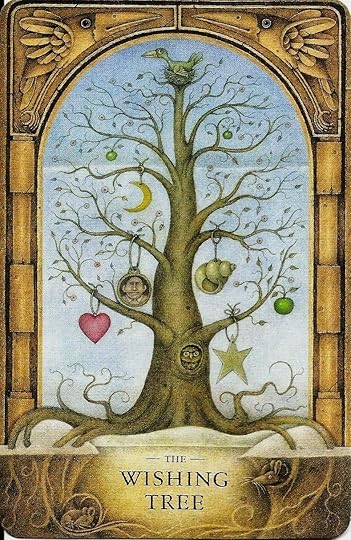 One of the StoryWorld cardswhich featured a place or an object. I asked them to find the link between their character and the subject of the new card.
One of the StoryWorld cardswhich featured a place or an object. I asked them to find the link between their character and the subject of the new card.
If you want to see the power of story in action, use these cards. We tell stories about everything, we think in stories, we teach with stories - and the excitement and glee of the children as they spot some detail in the card and 'discover' some new twist in their story, is beautiful to see. And I, as ever, was amazed and delighted by the ideas they came up with - things I would never have thought of, and never expected.
I gave them a little guidance - asked them to think about their endings.
At 11-30, I was fetched to the Senior School and there, immediately before lunch, I began the Creative Writing Workshop by telling, and breaking down, an Urban Myth. After lunch (which was very good) the girls divided into two groups and worked on their own stories. Again, I went round, seeing as many as I could, advising them to think about what kind of ending they wanted, so they knew where their story was heading.
At the end of the afternoon, we had a writers' surgery - all gathered in the lovely old school hall. We dragged chairs and benches into a big circle, and I grabbed the headmaster's throne.
The girls' teacher feared that they might be hesitant to criticise each other's work, and there'd be nothing but praise - but the girls had not only come up with very different stories - all complete with endings which ranged from happy to doom-laden - but gave each other excellent feedback on what had worked, and what was confusing, and what defied belief.
I stressed that this kind of criticism is an ordinary part of a writer's working life - that if someone said their story wasn't believable, they shouldn't be crushed. It simply meant that you rewrote the story, changing details, until it was believable.
And then I was out the door for a three hour drive home. After two hours, stopped at a Little Chef, for a coffee and bacon and eggs. The glamorous writer's life.
I wouldn't change it, though.
And have you guessed what the Urban Myth was yet?
 Photo: Wikimedia Commons, Pato Garza
Photo: Wikimedia Commons, Pato Garza
 Guess which Urban Myth I told...place in.
Guess which Urban Myth I told...place in.Over ten days, I went into three schools. I know some writers do much more, but these three visits involved long drives, overnight stays - and I get old, I get old. It was enough for me.
The first school was Arthur Mellow's Collegiate, near Peterborough. So that was a 200 mile drive and an overnight stay. In a chilly B&B, which wasn't quite as freezing as the one I stayed in during December, but still far from comfortable. B&B owners seem to think that England is a suburb of Melbourne, where December through to March is the hottest time of the year.
I spent the entire day at Arthur Mellows working with the same group of 'gifted and talented' pupils, presenting a Creative Writing Workshop. It's unusual, in my experience, for a school to be as bold as this, and I applaud it.
First I told the group a short story, an Urban Folktale.
Then I showed them how the suspense in that story was created, that it's not so much what happens in a story that creates the interest, but largely down to the way it's told. It doesn't matter, in fact, whether a story is about someone's life being endangered by a serial killer, or an old teddy-bear trying to find his lost owner - the story will follow the same pattern, and whether the story works or not will largely depend on how it follows that pattern.
I gave them copies of the story I told them, and had them identify the 'building blocks' of the story. Then I set them the task of inventing their own story, in brief outline. It could be any kind of story - provided it included all the building-blocks we'd looked at. In this way, I hoped to get them to invent a complete story, with a satisfactory ending - and not, as so often happens, to charge off into their first idea, and then be dissatisfied and disappointed because they couldn't find an ending.
They worked on their stories for an hour, while I went round finding out about them. There was an age-range from 11/12 to 14/15, and a wide range of subjects. I encouraged them all to start thinking about their ending. Who did they want to 'win'? Was it to end happily or sadly? With others, I discussed re-arranging their story's elements, to achieve a better structure.
In the hour immediately before lunch, we held a 'writer's surgery' where they heard each other's stories - which were wonderfully varied and imaginative - and gave each other feedback. How well had the building blocks been handled? What worked well about the story? What could be improved?
In the afternoon, we took a look at building character, and setting scene. I enjoyed the day enormously. One student wrote on her feedbac form (and entirely without coercion from me, as I'd left my knuckledusters at home): 'I want to be an author when I’m older and workshops like this one are inspiring and helpful. THANK YOU!'
 The Sterkarm Handshake At Cardinal Griffin, I've just been appointed their 'Patron of Reading,' and this was a first visit, a 'getting to know you' day. I saw several classes, for an hour each time, and told them something of my life, and about the ideas and research behind my book, The Sterkarm Handshake.
The Sterkarm Handshake At Cardinal Griffin, I've just been appointed their 'Patron of Reading,' and this was a first visit, a 'getting to know you' day. I saw several classes, for an hour each time, and told them something of my life, and about the ideas and research behind my book, The Sterkarm Handshake.And there was cake for lunch - baked by the lovely librarian, Jacqueline Biddle. Some senior students came along to join us - but had all eaten their packed lunches at break!
It was a fun day, with some very acute questions from the students, and I look forward to working with Griffin again.
Griffin was a mere hour's drive from home - but good lord, the traffic! At roughly 3-45pm, the traffic on Birmingham's car-park (the M6) was so horrendous that I pulled off and drove home through the urban sprawl of the Black Country, where, if you can credit it, the roads were quieter, and I was able to get out of second gear.
A pit-stop at home that night, and then next day I set out for Salisbury and my B&B.
I thought I was never going to get there. I drove and drove and drove, but the roads seemed to keep unwinding on an endless spool. I think I drove, that day, on every kind of road that exists in the UK (with the possible exception of the roads on the Isle of Mull and the Ardnamurchan Peninsula, whose unique roads sometimes take a break and disappear from view altogether.)
But after three hours and 120 miles (only 120? It felt like much more) I arrived at my B&B, which was on a farm, Swaynes Firs Farm. There were ornamental ducks, a very warm welcome from the charming landlord, and a good breakfast the next morning.
I was away at 7-30 am, to drive to the school, Godolphin, an independent girls' boarding school, founded in 1726. I spent the
 morning in the Prep school, where first I told the girls about myself in assembly - and then had a hugely enjoyable time until about half eleven.
morning in the Prep school, where first I told the girls about myself in assembly - and then had a hugely enjoyable time until about half eleven.First, I read my books, The Runaway Chapati, and How The Bear Lost His Tail, to the youngest. They chanted out the choruses, were afraid for the chapati, and sorry for the bear, and a good time was had by all.
Then I used the wonderful StoryWorld cards by John and Caitlin Matthews. Each card has a very detailed and beautiful picture on it, with questions to prompt ideas. The children were split into groups, and I gave each group a character card. When they'd had a moment to think about it, I gave them another card,
 One of the StoryWorld cardswhich featured a place or an object. I asked them to find the link between their character and the subject of the new card.
One of the StoryWorld cardswhich featured a place or an object. I asked them to find the link between their character and the subject of the new card.If you want to see the power of story in action, use these cards. We tell stories about everything, we think in stories, we teach with stories - and the excitement and glee of the children as they spot some detail in the card and 'discover' some new twist in their story, is beautiful to see. And I, as ever, was amazed and delighted by the ideas they came up with - things I would never have thought of, and never expected.
I gave them a little guidance - asked them to think about their endings.
At 11-30, I was fetched to the Senior School and there, immediately before lunch, I began the Creative Writing Workshop by telling, and breaking down, an Urban Myth. After lunch (which was very good) the girls divided into two groups and worked on their own stories. Again, I went round, seeing as many as I could, advising them to think about what kind of ending they wanted, so they knew where their story was heading.
At the end of the afternoon, we had a writers' surgery - all gathered in the lovely old school hall. We dragged chairs and benches into a big circle, and I grabbed the headmaster's throne.
The girls' teacher feared that they might be hesitant to criticise each other's work, and there'd be nothing but praise - but the girls had not only come up with very different stories - all complete with endings which ranged from happy to doom-laden - but gave each other excellent feedback on what had worked, and what was confusing, and what defied belief.
I stressed that this kind of criticism is an ordinary part of a writer's working life - that if someone said their story wasn't believable, they shouldn't be crushed. It simply meant that you rewrote the story, changing details, until it was believable.
And then I was out the door for a three hour drive home. After two hours, stopped at a Little Chef, for a coffee and bacon and eggs. The glamorous writer's life.
I wouldn't change it, though.
And have you guessed what the Urban Myth was yet?
 Photo: Wikimedia Commons, Pato Garza
Photo: Wikimedia Commons, Pato Garza
Published on March 07, 2015 04:49
February 20, 2015
A Night Out With The Stars...
Well, the stars of my world...
 The Royal Literary Fund
The Royal Literary Fund
The Royal Literary Fund has recently started a new venture. There are now two RLF centres, where events of various kinds are hosted, one in Bristol, and one in Birmingham.
There are two kinds of event. In the evening are the public events, where writing members of the RLF give readings, or take part in a panel discussion. The writers who make up the audience are welcome to bring along guests.
The other kind, held during the afternoon, are training days, where one or more writers pass on tips, tricks and wrinkles to other.The aim is to build a supportive community among writers - which already seems to be happening.
 The Birmingham Midland InstitureSo on Thursday last I went along to the first Birmingham one, held at the Birmingham Midland Institute in Margaret Street. It's a beautiful old Victorian building - in fact, my guest, my pubowrimo friend, came along as much for the chance to get inside this building, which he had often passed and wondered about, as for anything else.
The Birmingham Midland InstitureSo on Thursday last I went along to the first Birmingham one, held at the Birmingham Midland Institute in Margaret Street. It's a beautiful old Victorian building - in fact, my guest, my pubowrimo friend, came along as much for the chance to get inside this building, which he had often passed and wondered about, as for anything else.
Considering it was a cold, dark, wet, windy February evening, and that many people in the audience had travelled considerable distances, it was well attended. As one guest put it, 'I would crawl over broken glass if the RLF asked me to.' The RLF is a remarkable institution, which does inspire great affection and loyalty in its writers - but there was also a buzz of curiosity about this new scheme, and a feeling of priviledge at being in at the start.
The subject for the evening was 'Creating A Sense of Place.'
The three writers taking part were Jane Adams, Kerry Young and Helena Attlee.
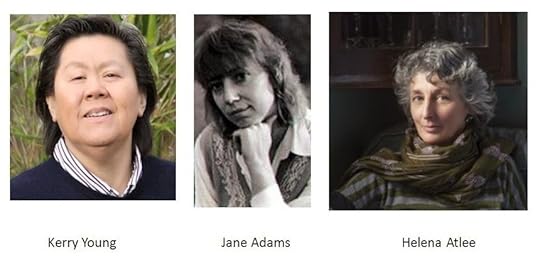
I know Jane Adams a little, because when I started as an RLF Fellow at De Montfort University, I took over from her - and she was extremely kind, in leaving me sheets of very helpful notes on the ins and outs of the university. I hope that she'll visit this blog soon, to tell us about the miniature knights she and her husband have been working on.
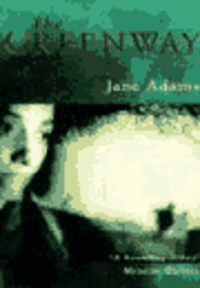 The Greenway by Jane AdamsJane read from her first novel - which obviously still means a lot to her. Called The Greenway, it's set in a place Jane remembered from her childhood, a place - The Greenway - which she found eerie and disturbing. She spoke of how much of our most vivid impressions are rooted in childhood memory.
The Greenway by Jane AdamsJane read from her first novel - which obviously still means a lot to her. Called The Greenway, it's set in a place Jane remembered from her childhood, a place - The Greenway - which she found eerie and disturbing. She spoke of how much of our most vivid impressions are rooted in childhood memory.
Kerry Young was born in Jamaica, of Chinese descent, and she was eager for us to experience Jamaica through her words - determined that we should. She read extracts from two of her books, Pau and Gloria. The first, to give us the tumultuous noise and smell of the city, Kingston. The second, from Gloria, was to give us the heat and stillness and harshness of life in the country, among the banana and cane plantations. She succeeded in her aim!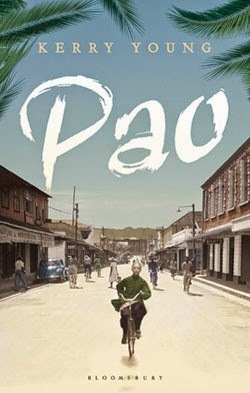 Pau by Kerry Young
Pau by Kerry Young
Helena Attlee is best known for writing about gardens and has travelled widely, particuarly in Italy. Her favourite method of capturing a sense of place is simply to travel with a notebook and pen, and to write down her impressions on the spot. These notebooks - rather like the sketch-pads of a painter - are an invaluable resource once she's back at her desk. They are full of details and impressions which had faded from her mind, but are captured, written down in her own words.
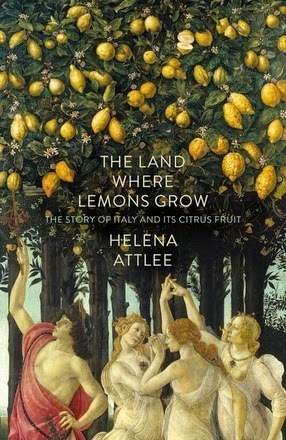 The Land Where Lemons Grow by Helena AtleeShe made me want to take a notebook to some far-flung spot on the instant.
The Land Where Lemons Grow by Helena AtleeShe made me want to take a notebook to some far-flung spot on the instant.
Instead, I joined the others in scoffing the sandwiches so thoughtfully provided by the RLF - and by Meg Sanders, the regional organiser. Also wine, red and white, and tiny delicious cakes. The RLF knows how to appeal to writers.
The next public RLF event is a poetry reading - I'm looking forward to it. I'm also booked in to deliver some events myself - to take part in a short-story reading, and a panel on research - and to present a training day on ebooks.
I'm hoping there'll be some more of those little eclairs...
 The Royal Literary Fund
The Royal Literary FundThe Royal Literary Fund has recently started a new venture. There are now two RLF centres, where events of various kinds are hosted, one in Bristol, and one in Birmingham.
There are two kinds of event. In the evening are the public events, where writing members of the RLF give readings, or take part in a panel discussion. The writers who make up the audience are welcome to bring along guests.
The other kind, held during the afternoon, are training days, where one or more writers pass on tips, tricks and wrinkles to other.The aim is to build a supportive community among writers - which already seems to be happening.
 The Birmingham Midland InstitureSo on Thursday last I went along to the first Birmingham one, held at the Birmingham Midland Institute in Margaret Street. It's a beautiful old Victorian building - in fact, my guest, my pubowrimo friend, came along as much for the chance to get inside this building, which he had often passed and wondered about, as for anything else.
The Birmingham Midland InstitureSo on Thursday last I went along to the first Birmingham one, held at the Birmingham Midland Institute in Margaret Street. It's a beautiful old Victorian building - in fact, my guest, my pubowrimo friend, came along as much for the chance to get inside this building, which he had often passed and wondered about, as for anything else.Considering it was a cold, dark, wet, windy February evening, and that many people in the audience had travelled considerable distances, it was well attended. As one guest put it, 'I would crawl over broken glass if the RLF asked me to.' The RLF is a remarkable institution, which does inspire great affection and loyalty in its writers - but there was also a buzz of curiosity about this new scheme, and a feeling of priviledge at being in at the start.
The subject for the evening was 'Creating A Sense of Place.'
The three writers taking part were Jane Adams, Kerry Young and Helena Attlee.

I know Jane Adams a little, because when I started as an RLF Fellow at De Montfort University, I took over from her - and she was extremely kind, in leaving me sheets of very helpful notes on the ins and outs of the university. I hope that she'll visit this blog soon, to tell us about the miniature knights she and her husband have been working on.
 The Greenway by Jane AdamsJane read from her first novel - which obviously still means a lot to her. Called The Greenway, it's set in a place Jane remembered from her childhood, a place - The Greenway - which she found eerie and disturbing. She spoke of how much of our most vivid impressions are rooted in childhood memory.
The Greenway by Jane AdamsJane read from her first novel - which obviously still means a lot to her. Called The Greenway, it's set in a place Jane remembered from her childhood, a place - The Greenway - which she found eerie and disturbing. She spoke of how much of our most vivid impressions are rooted in childhood memory.Kerry Young was born in Jamaica, of Chinese descent, and she was eager for us to experience Jamaica through her words - determined that we should. She read extracts from two of her books, Pau and Gloria. The first, to give us the tumultuous noise and smell of the city, Kingston. The second, from Gloria, was to give us the heat and stillness and harshness of life in the country, among the banana and cane plantations. She succeeded in her aim!
 Pau by Kerry Young
Pau by Kerry YoungHelena Attlee is best known for writing about gardens and has travelled widely, particuarly in Italy. Her favourite method of capturing a sense of place is simply to travel with a notebook and pen, and to write down her impressions on the spot. These notebooks - rather like the sketch-pads of a painter - are an invaluable resource once she's back at her desk. They are full of details and impressions which had faded from her mind, but are captured, written down in her own words.
 The Land Where Lemons Grow by Helena AtleeShe made me want to take a notebook to some far-flung spot on the instant.
The Land Where Lemons Grow by Helena AtleeShe made me want to take a notebook to some far-flung spot on the instant.Instead, I joined the others in scoffing the sandwiches so thoughtfully provided by the RLF - and by Meg Sanders, the regional organiser. Also wine, red and white, and tiny delicious cakes. The RLF knows how to appeal to writers.
The next public RLF event is a poetry reading - I'm looking forward to it. I'm also booked in to deliver some events myself - to take part in a short-story reading, and a panel on research - and to present a training day on ebooks.
I'm hoping there'll be some more of those little eclairs...
Published on February 20, 2015 16:00
February 13, 2015
Will You Be My Valentine? - Or Pubwrimo 4
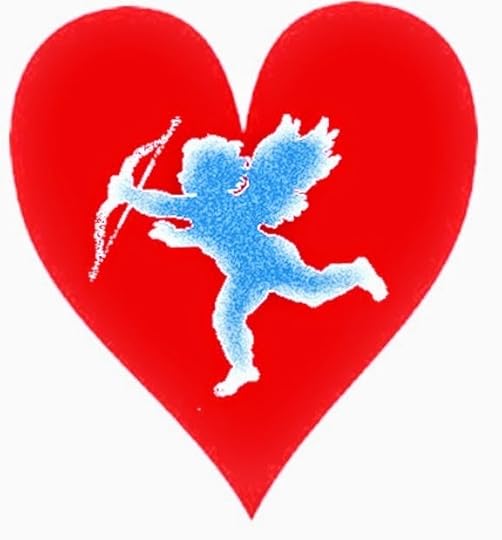
My friend couldn't make it to a pubwrimo this week, so, yesterday (Friday 13th, I'm not superstitious) I went on my own. At the bar, I reached into my bag, for money to pay for my cider - and pulled out a large red envelope I'd never seen before.
As I stared at it, the barman said, "Oooh, somebody's got a Valentine."
He could see what I couldn't - that on the side of the envelope facing him was written, 'Suzy' among some biro-drawn hearts.
So I went to my table, with my cider and my notebook, and ripped open the card. It was indeed a Valentine, slipped into my bag while my back was turned. It must have been done on Wednesday, which was the last time I saw him - and there was me being mardy because he spoiled my concentration on 'Wolf Hall' by pressing the button on the control, to see how much more time there was left in the recording (which makes a big red timer appear in the corner of the screen.) And accidentally leaned on the control, and switched the recording off, and then had to rewind all the way through the programme to find the place again... And falling asleep and snoring.
There was a badge on the card for me to wear today: 'A Perfect Valentine.' On the front, it read, 'I know I Drive You Mad Sometimes...But My Heart's In The Right Place...'
And inside: - 'Right Next To Yours!'
Altogether now: Aaaaaah.
 I had that very day bought him a Valentine. (Luckily.) In fact, I'd bought one earlier: a rather tasteful job which looked like an embroidered Victorian effort. But I lost it. Somewhere between me buying it and getting home, it vanished away.
I had that very day bought him a Valentine. (Luckily.) In fact, I'd bought one earlier: a rather tasteful job which looked like an embroidered Victorian effort. But I lost it. Somewhere between me buying it and getting home, it vanished away.So, while picking up a few groceries pre-pub, I'd bought another. A rather juicily throbbing large red card, with gold lettering: To The One That I Love. Not really what I wanted, but all the others had 'Boyfriend' or 'Husband' on them.
It had a verse inside, about wanting to spend every second of every minute of every day with the one that I love... Which sounded to me like something a stalker would write. So I neatly crossed it out and wrote in my own message.
Then I got on with proper business. It is 1-50 in the afternoon. It is the pub. There is cider. Write!
As usual, the pubowrimo magic worked and the writing flowed. My Bad Girl is tickled that her step-daughter thinks she can protect her grandmother, and sets out to demonstrate that she can cause GBH right under the step-daughter's nose and leave no incriminating evidence. She succeeds - and I think she'll go on to pose as the injured grandmother's rescuer, and one far more caring and attentive than the granddaughter could ever be. But that's the next pubowrimo.
I think I've written the usual 2000 words or so, but I haven't typed them up yet, so I don't have an accurate word-count.
On the way home, I stopped off at my Valentine's flat, sneaked in, and poked his Valentine into his letterbox - and snuck off again.
But I think I owe him something a bit more stylish and personal. But I'm really not up to handcrafting anything.
So I came up with the Cupid. It suddenly occurred to me how to do it. Get a clipart heart - download and save it to desktop.
Open Powerpoint, and insert the heart as a picture into a slide.

Find a clipart Cupid - this one was a black silhouette. Insert him in the centre of the heart. - But this leaves a white square all around the Cupid, which I didn't want.
Click on the pictures in Powerpoint, and this highlights 'Picture Tools' at the top of the screen. Click on that, and it opens the art menu.
Go to 'Colour', third from the left. This opens a menu which offers, at the bottom, 'Set Transparent Colour.'
I set white as the transparent colour - which meant the white square around Cupid disappeared as the red heart showed through from underneath.
I then clicked on 'Artistic Effects' next along, and tried them all until I found one I liked - it turned Cupid into a silvery grey, shadowed figure instead of a solid black silhouette.
So then I pressed the 'Print Screen' key.
I opened my Paint programme, pressed Ctrl + V, and the image of the Powerpoint Screen appeared in the Paint programme. I saved it as a jpeg.
I then opened it in Windows Photo Gallery, and used 'Fix' to crop the picture to just the heart and cupid. I changed the exposure, contrast and colour until it was as I wanted it. Then I saved it again, as a jpeg.
And you use Paint to flip the image, so it faces the other way. Or to add shadow and definition to the heart. Even an arrow, if you have a steady hand with a mouse. Or a graphics pen. [Later. I added an arrow in flight using 'insert shapes' in powerpoint.]
It sounds complicated, but took very little time. Less than it's taken me to write this blog. I imagine you could use Powerpoint to arrange several images in a similar way, though I haven't tried. Yet.
 I've no doubt the whole process is blindingly obvious to anyone who uses computers for artwork - but the whole idea just dropped into my head a few minutes ago. It comes from having used Powerpoint a lot just lately. I have to admit, I'm rather chuffed with my simple, stoopid little cupid.
I've no doubt the whole process is blindingly obvious to anyone who uses computers for artwork - but the whole idea just dropped into my head a few minutes ago. It comes from having used Powerpoint a lot just lately. I have to admit, I'm rather chuffed with my simple, stoopid little cupid.
Published on February 13, 2015 16:00
February 6, 2015
Pubowrimo 3
2, 278 words.
That's how many I got done in this week's pubowrimo.
First, I went off to a garden centre, to buy some in-the-green snowdrops. And some winter aconite and a hellebore, because they were there.
The hellebore is beautiful, and reminds me of my mother. She always called it 'a Christmas rose.' Christmas Rose
Christmas Rose
I love the aconite. It's bright yellow, and smells of honey.
And of course I love snowdrops. That goes without saying.
 Wafts of honey scent... I also bought a large - a very large - plastic pot, because I caught Diarmuid Gavin on TV, making a 'container water-garden' to attract insects to the garden by adding another eco-system, in miniature. I loved the idea. And since it seems fairly simple and inexpensive, I'm set on doing it. So I've got the pot. The plants will have to wait until later, I think, until water stops turning to stone in my back-yard. I know the water plants are hardy - even the water-lily, it seems, tough as old boots - but they'll have enough trouble surviving anywhere near me without adding sub-zero temperatures to their lot.
Wafts of honey scent... I also bought a large - a very large - plastic pot, because I caught Diarmuid Gavin on TV, making a 'container water-garden' to attract insects to the garden by adding another eco-system, in miniature. I loved the idea. And since it seems fairly simple and inexpensive, I'm set on doing it. So I've got the pot. The plants will have to wait until later, I think, until water stops turning to stone in my back-yard. I know the water plants are hardy - even the water-lily, it seems, tough as old boots - but they'll have enough trouble surviving anywhere near me without adding sub-zero temperatures to their lot.
Anyway, afterwards, I met up with my friend, and we went to the pub, bought cider and settled in - in the corner by the fire this time.
I had a quite tricky part to write, where a character has been set up by another, so it seems that he's made a serious suicide attempt. This results in him being sectioned under the Mental Health Act and admitted to a secure ward. I had no idea how to tackle this.
But as soon as I walked through the door of the pub, ideas started to pop. It's all becoming a bit Pavlovian. Pub = write.
Two thousand, two hundred and seventy-eight words. And I'm getting some ideas for the next part too. The gloves are coming off. The Bad Girl is baring her teeth and becoming frankly murderous - and the object of her homicidal intentions is a character uncomfortably like my beloved auntie. I didn't realise I was basing this character on Beloved Auntie until she was firmly established and it was too late. It's a little inhibiting. Has anyone else found themselves authorially threatening the life of a favourite relative?
My friend reports that he managed another solid 700 words - and he's pleased because he didn't think he'd be able to write anything this week. He also confesses to two unofficial pubowrimos at home - domestowrimos, I suppose. With tea instead of cider. He's trying to steal a march on me. He did another 700-ish words in each stint.
Ha! I'm still ahead.
Not that it's at all competitive, of course.
The secret, I think, is a free-flowing, scribbly pen that flows easily over the paper, without needing any pressure. The writing is sometimes hard to decipher when you come to type it up, but you can't half cover the pages.

That's how many I got done in this week's pubowrimo.
First, I went off to a garden centre, to buy some in-the-green snowdrops. And some winter aconite and a hellebore, because they were there.
The hellebore is beautiful, and reminds me of my mother. She always called it 'a Christmas rose.'
 Christmas Rose
Christmas RoseI love the aconite. It's bright yellow, and smells of honey.
And of course I love snowdrops. That goes without saying.
 Wafts of honey scent... I also bought a large - a very large - plastic pot, because I caught Diarmuid Gavin on TV, making a 'container water-garden' to attract insects to the garden by adding another eco-system, in miniature. I loved the idea. And since it seems fairly simple and inexpensive, I'm set on doing it. So I've got the pot. The plants will have to wait until later, I think, until water stops turning to stone in my back-yard. I know the water plants are hardy - even the water-lily, it seems, tough as old boots - but they'll have enough trouble surviving anywhere near me without adding sub-zero temperatures to their lot.
Wafts of honey scent... I also bought a large - a very large - plastic pot, because I caught Diarmuid Gavin on TV, making a 'container water-garden' to attract insects to the garden by adding another eco-system, in miniature. I loved the idea. And since it seems fairly simple and inexpensive, I'm set on doing it. So I've got the pot. The plants will have to wait until later, I think, until water stops turning to stone in my back-yard. I know the water plants are hardy - even the water-lily, it seems, tough as old boots - but they'll have enough trouble surviving anywhere near me without adding sub-zero temperatures to their lot.Anyway, afterwards, I met up with my friend, and we went to the pub, bought cider and settled in - in the corner by the fire this time.
I had a quite tricky part to write, where a character has been set up by another, so it seems that he's made a serious suicide attempt. This results in him being sectioned under the Mental Health Act and admitted to a secure ward. I had no idea how to tackle this.
But as soon as I walked through the door of the pub, ideas started to pop. It's all becoming a bit Pavlovian. Pub = write.
Two thousand, two hundred and seventy-eight words. And I'm getting some ideas for the next part too. The gloves are coming off. The Bad Girl is baring her teeth and becoming frankly murderous - and the object of her homicidal intentions is a character uncomfortably like my beloved auntie. I didn't realise I was basing this character on Beloved Auntie until she was firmly established and it was too late. It's a little inhibiting. Has anyone else found themselves authorially threatening the life of a favourite relative?
My friend reports that he managed another solid 700 words - and he's pleased because he didn't think he'd be able to write anything this week. He also confesses to two unofficial pubowrimos at home - domestowrimos, I suppose. With tea instead of cider. He's trying to steal a march on me. He did another 700-ish words in each stint.
Ha! I'm still ahead.
Not that it's at all competitive, of course.
The secret, I think, is a free-flowing, scribbly pen that flows easily over the paper, without needing any pressure. The writing is sometimes hard to decipher when you come to type it up, but you can't half cover the pages.

Published on February 06, 2015 16:00
January 30, 2015
Mysterious Purchaser, Somewhere In The UK...
I wasn't going to put up a blog this week - pressure of work and all that. I'm trying to prepare a series of workshops I have to give in schools at the end of February and beginning of March.

And then, there's no pubowrimo to report on this week - partly because of the workshops, but also because, living on top of the steepest hills for miles around, we were snowed in. A more courageous driver could have made it out to a decent, writer-tolerant pub - but after pirouetting my car like an ice-dancer on our steep hills a few times in recent years, I decided to pass.
I changed my mind about blogging when I logged on to CreateSpace, Amazon's Print-On-Demand Paperback site. I was intending to upload the 'interior' of 'Overheard In A Graveyard', one of my ghost story collections. But before I could do anything useful like that I was transfixed by the fact that this month's sales of my book The Wolf's Footprint, had jumped up from 5 to 23 since the last time I worked on the site, a couple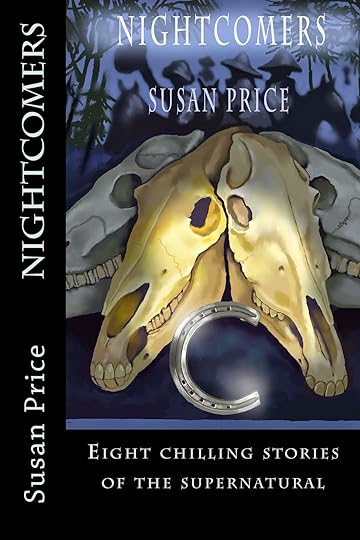 Nightcomers - already a paperbackof days ago.
Nightcomers - already a paperbackof days ago.
The reason I put 'The Wolf's Footprint' out, first as an ebook, and then as a paperback, was because so many teachers emailed me, asking where they could find copies of the book. One teacher asked if I could supply 16 copies. I couldn't - I never owned 16 copies at one time myself.
So I can only imagine that the reason for this sudden, even if modest, spike in sales is that, somewhere in the UK, a teacher, or a school, has lashed out and bought 18 copies of the book at one go.
Mysterious bulk purchaser, whoever, wherever you are, thank you very much! Please accept a writer's gratitude. I hope the book
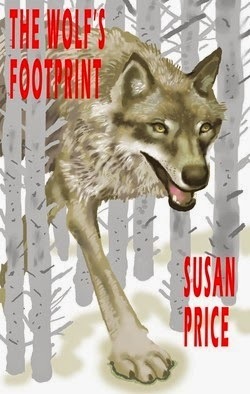 serves your purpose, and the story and illustrations are enjoyed.
serves your purpose, and the story and illustrations are enjoyed.
Mysterious Purchaser, you've made my weekend.
The paperback edition of The Wolf's Footprint can be found here, with greyscale illustrations..
A paperback edition with COLOUR illustrations can be found here.
And the ebook edition can be found here.
And I can't resist saying, have a look at this - http://thezazzledimp.blogspot.co.uk/2015/01/copywriters.html
You can put words in famous writers' mouths. I love Lovecraft saying, 'Boo!'

And then, there's no pubowrimo to report on this week - partly because of the workshops, but also because, living on top of the steepest hills for miles around, we were snowed in. A more courageous driver could have made it out to a decent, writer-tolerant pub - but after pirouetting my car like an ice-dancer on our steep hills a few times in recent years, I decided to pass.
I changed my mind about blogging when I logged on to CreateSpace, Amazon's Print-On-Demand Paperback site. I was intending to upload the 'interior' of 'Overheard In A Graveyard', one of my ghost story collections. But before I could do anything useful like that I was transfixed by the fact that this month's sales of my book The Wolf's Footprint, had jumped up from 5 to 23 since the last time I worked on the site, a couple
 Nightcomers - already a paperbackof days ago.
Nightcomers - already a paperbackof days ago.The reason I put 'The Wolf's Footprint' out, first as an ebook, and then as a paperback, was because so many teachers emailed me, asking where they could find copies of the book. One teacher asked if I could supply 16 copies. I couldn't - I never owned 16 copies at one time myself.
So I can only imagine that the reason for this sudden, even if modest, spike in sales is that, somewhere in the UK, a teacher, or a school, has lashed out and bought 18 copies of the book at one go.
Mysterious bulk purchaser, whoever, wherever you are, thank you very much! Please accept a writer's gratitude. I hope the book
 serves your purpose, and the story and illustrations are enjoyed.
serves your purpose, and the story and illustrations are enjoyed.Mysterious Purchaser, you've made my weekend.
The paperback edition of The Wolf's Footprint can be found here, with greyscale illustrations..
A paperback edition with COLOUR illustrations can be found here.
And the ebook edition can be found here.
And I can't resist saying, have a look at this - http://thezazzledimp.blogspot.co.uk/2015/01/copywriters.html
You can put words in famous writers' mouths. I love Lovecraft saying, 'Boo!'
Published on January 30, 2015 16:00
Susan Price's Nennius Blog
"I have made a little heap of all I've found..."
"I have made a little heap of all I've found..."
...more
- Susan Price's profile
- 71 followers



